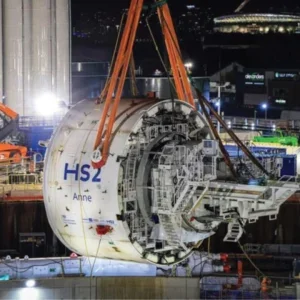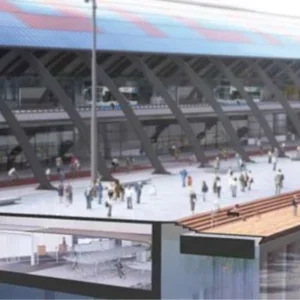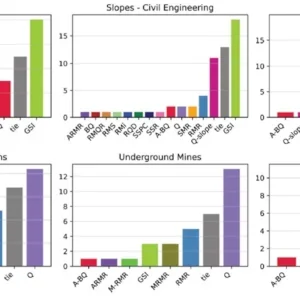Some thirty years ago, the Municipality of Naples was preparing to build a tramline to prepare the city for the Italia ’90 Fifa World Cup.
Flash forward a few years, and works have been interrupted for almost a decade due to administrative checks within the concession between Azienda Tramvie Autofilovie Napoli (ATAN) and Ansaldo, which was followed by a new concession between Naples Municipality and Ansaldo. In 1999 the change of the concession was approved and work began again in 2000.
Naples then opted for a metro system rather than a tram, as this newly-imagined Metro Line 6, would fit into the larger transport system, and allow for further metro development.
Ansaldo assigned the contract for the design and construction of civil works to a joint venture of Società Paolo De Luca Costruzioni Generali , supported by Metropolitana di Napoli, Costrade and Napoli Metro.
“We began work where the previous project had stopped, so we faced a number of challenges. Firstly, we had to make sure that the TBM could launch through an existing 200m tunnel,” says Giuseppe Molisso, senior programme manager at Ansaldo.
“We had to plan the disassembly and disposal of the previous TBM used, back-up included. We then had to consolidate and waterproof the area around the abandoned cutterhead.”
LINE 6 COMPOSITION
Line 6 is a 7km single tube housing a double track. It is designed to have a transport capacity of 7,200 passengers per hour in each direction.
The line features nine underground stations and three interchanges: one with Line 1 at Municipio station, another one is located at Mergellina with a railway link to Line 2; the other is at Piazza Tecchio with Mostra Station of the Line 7.
Structural tunnel design was by Rocksoil. The first section Mostra to Mergellina has been in operation since 2007; it has a length of 2.2km with four stations and two interchanges.
Works are currently in progress from Mergellina towards Municipio, apart from station work.
And works are scheduled to begin next year from Mostra to Campegna. The whole project costs EUR 1bn (USD 1.16bn). The whole line is due to be finished by 2020.
EXCAVATION
As Tunnels and Tunnelling goes to press, some 3.5km of 8m-diameter tunnel has been excavated with a Wirth EPBM, rented to the contractor by Seli.
Molisso explains that they had to enlarge the shaft at the Mergellina launch site, which was quite small at 12x12m. “We had to enlarge it by 6m, giving a 18x12m footprint, but keeping the depth at 20m,” he says. “The TBM had to be lowered down and then assembled within the 200m excavated 20 years ago. The whole operation had been done during night shifts to avoid any disturbance.
The TBM started its journey from Mergellina and crossed the station footprint in full face mode because the station box had not yet been built, and structural bulkheads were not yet in place. The delay was due to continuing archaeological concerns, which have also heavily delayed the project.
The 8.165m-diameter TBM worked in two types of ground during its 18 months of operation between 2010 and 2011. The first section, a drive of about 1.6km to Piazza Victoria, is in soft ground comprising Pozzolana and fine sand grain, which are incoherent materials completely sunk into an aquifer. “It was quite hard to work through and it took 12 months to complete,” Molisso says.
The second section of about 1.4km from Piazza Vittoria to Piazza Municipio (City Hall) is made of yellow tuff, which has an easy workability and good insulation properties and so it took six months to bore.
“We worked together with professor Carlo Viggiani from Naples University’s Civil, Building and Environmental Engineering department, (ICEA) to better understand the composition of ground and how to deal with it,” adds Molisso. Bucket conveyors transported spoil from the face to the Mergellina site, which was the only mucking shaft. Trucks then transported spoil to authorised landfills.
Monitoring
“In terms of monitoring, we had to go through a very delicate phase as we had to work in a dense urban environment amongst historical and artistic buildings as well,” Molisso says.
All of the data was entered into centralised system to check all the variations, and comparing them with behaviours predicted during the planning stage, taking into account both the middle and long term. The system was accessible to all workers to check the potential risk of settlement induced on existing buildings. Monitoring instruments included piezometers, inclinometers,
strain-gauges. Tre Esse was contracted to monitor any movement of the historically and artistically significant buildings nearby. Phonometric analysis was also performed at lifting points, specific points inside the TBM and around site plant.
CHANGING DEPTH
During construction, it became necessary to alter the depth of the tunnel. The foundations of one building above the alignment were lower than indicated. “A particular challenge was the need to change the level at Piazza Vittoria,” Molisso says. “I recall that it was a crucial moment, and we needed to take a decision in short order, as the TBM was advancing and we couldn’t stop.
“So we had to calculate the effect of changing the tunnel’s depth on the whole project, evaluating systemic and geometric impacts. We moved quickly and decided to change tunnel’s altimetry, making it 1.5m deeper. A task force was also formed to mitigate the risk of settlement. We also had to make changes at San Pasquale and Chiaia stations, notably the tunnel gradient as well as the depth of the slab.”
No reportable issues arose from the changes.
MICRO TUNNEL
The contractor excavated four ventilation shafts through a Herrenknecht Vertical Shaft Sinking Machine (VSM), which worked from the top to the bottom with a diameter of 3.2m. These ventilation shafts were linked to the tunnel by 3m-long tunnels. At the Plebiscito ventilation shaft the linking tunnel needed built with a 100m-long microtunnel drive. The microtunnel has a slope of 8% with an inner diameter of 3m and the outer diameter is 3.5m. The other two ventilation shafts are 7 and 10m long. The VSM is equipped with a remote control closed shield and with a hydraulic spoil.
Lining
Manufactured in Lazio, segments were delivered to a local depot before being transported by lorries to the Mergellina shaft.The lining is formed of nine segments in an 8+key arrangement. The segments are 1.7m long with a depth of 350mm.
The lining system includes longitudinal connectors between segments of adjacent rings; socket inserts with Vacuum erector, situated in the middle of segments; EPDM gaskets placed around each segment on all the four faces in contact with other segments; rod bars positioned on the contact surfaces between segments of the same ring.
VENTILATION
To maintain air quality in the tunnels, a ventilation system was implemented to eliminate or dilute gas, dusts and dangerous concentrations of fumes. Each worker is ensured a minimum of 3cu.m of fresh air per minute. The air is be introduced underground through ventilation systems, and collected at locations determined to be far enough away from potential pollution sources. The whole ventilation setup has been carried out in progression and uses a ‘pressing system’, with fresh air picked up from outside using an axial fan. This system wicks air to the excavation face through a polyester pipe (2,460 litres/m2). Measurements are periodically required to check efficiency of the plant in addition to recordings through hot-film anemometer and stored in a ventilation register.
ARCHITECTURE
Naples is known for its architecture and history, and during a conference that acted as a precursor to WTC 2019, Molisso took time to talk about the stations.
San Pasquale station
The recently built San Pasquale station is located near the Aquarium pavilion and the historical building of Villa Pignatelli. This station aims to serve mainly residential and commercial users. Implemented by the architect Boris Podrecca, the project includes a large metal shell, which completely surround the perimeter of the station. The metal shell symbolises the traditional fishing nets/traps typical in the Naples region.
Arco Mirelli station
Arco Mirelli station is located along the Riviera di Chiaia and ensures access to one of the most important, tourist areas of the city. Developed by architect Hans Kolloff, the project shows the realisation of a single and balanced glass pavilion, and thanks to its light and linear steel structure, it suggests the design of the large universal expositions of the Nineteenth century.
Chiaia station
Chiaia station is based in the heart of Chiaia district and was designed by architect Siola and associates at studio PROTEC. It is situated vertically between Piazza di Santa Maria degli Angeli and homonym street, with a difference of around 40m from the square level to the platform level. The architectural structure of the plan ensures, through the presence of a helicoidal path, the interconnection between the square surface and the mezzanine level. A steel and crystal segmental arch is placed to cover the entire plan, which unifies and enhances the image of the entire station.
Municipio station
Municipio station was designed by Alvaro Siza Vieria and Eduardo Souto de Moura architects, who have left traces of a contemporary presence at two lines. Line 1 is the deeper one, whereas Line 6 is placed crosswise to Line 1.
This station acts as an important interchange between the two lines, achieving a fundamental relationship between the metropolitan networks, commercial, residential and tourist areas of the city.
The station features basic but also artistic elements, such as the conservation of the textures of wooden bodyworks on concrete surfaces, marble slab textures of rough staggered bricks, stones and white plasters. Both Portuguese artists aimed to combine the archaeology of the old city found during the work with the restoration to new usable spaces and paths connecting the city with the international transport networks.






